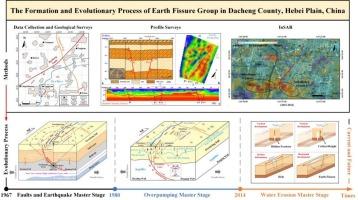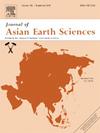The formation and evolutionary process of earth fissure group in Dacheng County, Northern Hebei Plain, China
IF 2.4
3区 地球科学
Q2 GEOSCIENCES, MULTIDISCIPLINARY
引用次数: 0
Abstract
Nearly a thousand earth fissures have developed in the Hebei Plain, with a total length exceeding 100 km, making it one of the most severely affected areas by earth fissure disasters in China. Approximately 70 % of the earth fissures in the Hebei Plain are tectonic in nature, among which the earth fissure groups in Dacheng County are a typical example, causing significant economic losses locally. To reveal the genetic mechanisms of the earth fissure groups in Dacheng County, methods including historical data collection, geological surveys, measurements, trenching, drilling, geophysical exploration, and InSAR were employed to investigate their development process and analyze the evolution of controlling factors across different periods. The results show that the current earth fissure group in Dacheng County consist of eight earth fissures, predominantly striking NE and parallel to Dacheng faults, with a total length of 5 km. Most earth fissures are located on the hanging wall of faults, with damage manifested as field ruptures and sinkholes, primarily causing tensile damage to buildings. On shallow profiles, there is no significant vertical displacement of strata, but faults are present at greater depths and correspond to the locations of the main earth fissures. The development of the earth fissure groups in Dacheng County is considered to have occurred in three distinct stages. Initially, the first exposure of the earth fissure groups was triggered by seismic forces that activated the underlying faults, resulting in numerous vertical fractures within the overlying soil. Some of these vertical fractures extended to the surface, forming earth fissures, while others remained concealed, laying the structural foundation for the continued development of the earth fissure groups. Secondly, the overpumping of groundwater led to differential settlement of the soil layers, accelerating the exposure and expansion of the earth fissures. Finally, significant surface water from heavy rainfall and irrigation infiltrated through the fractures, with intense water erosion causing the earth fissures to repeatedly expose at the surface. This study has significant guiding importance and practical value for the research and prevention of earth fissures in the Hebei Plain.

冀北平原大城县地裂缝群的形成与演化过程
河北平原发育了近千条地裂缝,总长度超过100公里,是中国地裂缝灾害最严重的地区之一。河北平原约70%的地裂缝为构造性地裂缝,其中大城县地裂缝群为典型,给当地造成了重大经济损失。为揭示大城县地裂缝群的成因机制,采用历史资料收集、地质调查、测量、沟探、钻探、物探、InSAR等方法,研究了大城县地裂缝群的发育过程,分析了不同时期控制因素的演化。结果表明,大城县现今的地裂缝群由8条地裂缝组成,以NE向为主,与大城断裂平行,全长5 km。地裂缝多位于断层上盘,破坏表现为场破裂和天坑,主要对建筑物造成张拉破坏。在浅层剖面上,没有明显的地层垂直位移,但在较深的地方存在断层,并与主要地裂缝的位置相对应。认为大城县地裂缝群的发育分为三个不同的阶段。最初,地震力激活了下面的断层,引发了地面裂缝群的首次暴露,导致上覆土壤中出现了许多垂直裂缝。这些垂直裂缝有的向地表延伸,形成地裂缝,有的仍处于隐伏状态,为地裂缝群的持续发育奠定了构造基础。其次,地下水超采导致土层的差异沉降,加速了地裂缝的暴露和扩大。最后,来自强降雨和灌溉的大量地表水通过裂缝渗透,强烈的水侵蚀导致地表裂缝反复暴露。该研究对河北平原地裂缝的研究和防治具有重要的指导意义和实用价值。
本文章由计算机程序翻译,如有差异,请以英文原文为准。
求助全文
约1分钟内获得全文
求助全文
来源期刊

Journal of Asian Earth Sciences
地学-地球科学综合
CiteScore
5.90
自引率
10.00%
发文量
324
审稿时长
71 days
期刊介绍:
Journal of Asian Earth Sciences has an open access mirror journal Journal of Asian Earth Sciences: X, sharing the same aims and scope, editorial team, submission system and rigorous peer review.
The Journal of Asian Earth Sciences is an international interdisciplinary journal devoted to all aspects of research related to the solid Earth Sciences of Asia. The Journal publishes high quality, peer-reviewed scientific papers on the regional geology, tectonics, geochemistry and geophysics of Asia. It will be devoted primarily to research papers but short communications relating to new developments of broad interest, reviews and book reviews will also be included. Papers must have international appeal and should present work of more than local significance.
The scope includes deep processes of the Asian continent and its adjacent oceans; seismology and earthquakes; orogeny, magmatism, metamorphism and volcanism; growth, deformation and destruction of the Asian crust; crust-mantle interaction; evolution of life (early life, biostratigraphy, biogeography and mass-extinction); fluids, fluxes and reservoirs of mineral and energy resources; surface processes (weathering, erosion, transport and deposition of sediments) and resulting geomorphology; and the response of the Earth to global climate change as viewed within the Asian continent and surrounding oceans.
 求助内容:
求助内容: 应助结果提醒方式:
应助结果提醒方式:


